
May 2011
Welcome to Net Results EXPRESS
Net Results EXPRESS (NRx) is an award-winning, monthly e-newsletter highlighting medical and scientific breakthroughs, major grants and honours awarded, and other research-related events at UHN. Through NRx you can read about ongoing research at our three research institutes, the Ontario Cancer Institute (OCI), the Toronto General Research Institute (TGRI), and the Toronto Western Research Institute (TWRI). We hope you will find this newsletter informative and helpful. If you have feedback or questions, please contact www@uhnresearch.ca Christopher J. Paige, PhD, FCAHS |
Health Services Research at UHN: Strategic Planning Workshop
This workshop was funded by the Canadian Institutes of Health Research. |
Prostate Cancer: New Findings on the Effects of Supplements
303 men received daily treatment with these supplements over a period of three years. The researchers examined the development of PCa and determined that there was no effect. "To our chagrin, there was no benefit," says Dr. Fleshner “26% of patients developed PCa, regardless of whether or not they were in the dietary supplement group or the placebo group. Given our conditions, this trial does not support the idea that vitamin E, selenium and soy prevent PCa progression.” Progression from high-grade prostatic intraepithelial neoplasia tocancer: A randomized trial of combination vitamin-E, soy, and selenium. Fleshner NE, Kapusta L, Donnelly B, Tanguay S, Chin J, Hersey K, Farley A, Jansz K, Siemens DR, Trpkov K, Lacombe L, Gleave M, Tu D, Parulekar WR. Journal of Clinical Oncology. 2011 May 2. [Pubmed abstract] This work was supported by a grant from the Canadian Cancer Society Research Institute and the Princess Margaret Hospital Foundation.
|
Cancer: A New Mechanism for Resistance to Therapy
Understanding how tumour cells alter their metabolic processes to adapt to changing conditions can provide new targets and therapies for the treatment of cancer. A recent study from an OCI team led by Dr. Tak Mak, details a new mechanism of adaptation by tumour cells through the function of the gene carnitine palmitoyltransferase 1C (CPT1C). Tumour cells undergo metabolic transformation (MT) to limit their consumption of energy while simultaneously increasing energy production. MT typically occurs in situations where a tumour is attempting to adapt to therapy. This study is the first to identify CPT1C as a gene that is elevated in tumours undergoing MT and responsive to unfavourable changes in the environment of the tumour. It is also associated with an increased change in energy production. “CPT1C is a potential alternative energy supply gene that is induced in tumours during the process of MT,” says Dr. Mak. When they depleted CPT1C in tumours, energy production decreased and cells were more sensitive to drugs causing metabolic stress. “These results suggest that an anti-CPT1C therapy, used alone or in combination with other anti-cancer agents, may be a promising new avenue of cancer treatment,” adds Dr. Mak. Carnitine palmitoyltransferase 1C promotes cell survival and tumor growth under conditions of metabolic stress. Zaugg K, Yao Y, Reilly PT, Kannan K, Kiarash R, Mason J, Huang P, Sawyer SK, Fuerth B, Faubert B, Kalliomäki T, Elia A, Luo X, Nadeem V, Bungard D, Yalavarthi S, Growney JD, Wakeham A, Moolani Y, Silvester J, Ten AY, Bakker W, Tsuchihara K, Berger SL, Hill RP, Jones RG, Tsao M, Robinson MO, Thompson CB, Pan G, Mak TW. Genes & Development. 2011, May 15, 25(10):1041-51. [Pubmed abstract] This study was supported by grants from the Forschungskredit of the University of Zurich and Oncosuisse, the Canadian Cancer Society, the Princess Margaret Hospital Foundation, and the Canadian Institutes of Health Research. |
Leukemia: Helping the Immune System Fight Cancer
Double negative T (DNT) cells are immune cells involved in the body’s defense against cancer. This group has previously shown that DNT cells protect mice injected with leukemic cells from developing the disease. In the current study, researchers isolated DNT cells from blood samples taken from AML patients who were previously treated with standard chemotherapy. The DNT cells were grown in an incubator for a period of two weeks to increase the total number of cells. When exposed to leukemic cells drawn from AML patients, they observed that the DNT cells could effectively kill the leukemic cells. “We’ve provided evidence that expanded DNT cells could be used as a new immunotherapy against leukemia,” states Dr. Zhang. “Not only could the use of DNT cells improve the survival of AML patients already treated with chemotherapeutics but we also could be embarking on a new way of treating many other types of human cancer.” Anti-leukemia effect of ex vivo expanded DNT cells from AML patients: a potential novel autologous T-cell adoptive immunotherapy. Merims S, Li X, Joe B, Dokouhaki P, Han M, Childs RW, Wang ZY, Gupta V, Minden MD, Zhang L. Leukemia. 2011 May 13. [Pubmed abstract] This work was supported by grants from the Ontario Institute for Cancer Research and the Canadian Cancer Society. |
Parkinson’s Disease: Enhancing the Therapeutic Benefits of L-DOPA
In a recent study led by TWRI’s Dr. Jonathan Brotchie, researchers examined how the different forms of MDMA function to enhance the positive therapeutic effects of L-DOPA. Using a primate model of PD, the investigators administered L-DOPA with either the R- form or the S- form of MDMA. These two forms of MDMA are chemically identically but have different structural orientations which can lead to differing effects. They found that the addition of R-MDMA to L-DOPA treatment decreased the severity of dyskinesia while the length of time of the antiparkinsonian effects remained unchanged. However, the addition of S-MDMA to L-DOPA treatment increased the length of time of the antiparkinsonian benefits, however it exacerbated the following dyskinesia. R- and S-MDMA bind to different forms of the seratonin receptor, another neurotransmitter in the brain, accounting for their different therapeutic effects. “While MDMA cannot be developed clinically due to psychoactivity and potential neurotoxicity, this study helps to refine the interactions between different neurological systems involved in PD, and may help lead to new drug discovery programs for the treatment of PD,” explains Dr. Brotchie. Characterization of 3,4-methylenedioxymethamphetamine (MDMA) enantiomers in vitro and in the MPTP-lesioned primate: R-MDMA reduces severity of dyskinesia, whereas S-MDMA extends duration of ON-time. Huot P, Johnston TH, Lewis KD, Koprich JB, Reyes MG, Fox SH, Piggott MJ, Brotchie JM. Journal of Neuroscience. 2011 May 11;31(19):7190-8. [Pubmed Abstract] This work was supported by the Cure Parkinson Trust and the Krembil Neuroscience Fund. |
Neuroscience: Understanding the Effect of Seizures in Stroke Patients
The team used a surgically induced experimental model of stroke that results in a pattern and course of brain injury that closely resembles clinical symptoms of stroke. Generalized motor seizures, the inappropriate activation of the motor area of the brain leading to spasms in muscle groups, were observed in animals with extensive brain injury and it was determined that these seizures did not originate from areas of the brain that were close to the stroke-induced lesion (the area of the brain that is immediately damaged following a stroke episode). Animals with post-stroke seizures also had a higher rate of mortality. Moreover, when the anti-convulsive drugs phenytoin and diazepam were administered after stroke, the incidence of seizure and mortality were significantly reduced. "Though using the anti-convulsant drugs helped to reduce mortality, they did not help with the extent of brain injury," states Dr. Zhang. "It remains to be tested whether other anti-convulsants, particularly those with a wide pharmacological spectrum, are more effective in protecting against stroke-induced brain injury." Acute postischemic seizures are associated with increased mortality and brain damage in adult mice. El-Hayek YH, Wu C, Chen R, Al-Sharif AR, Huang S, Patel N, Du C, Ruff CA, Fehlings MG, Carlen PL, Zhang L. Cerebral Cortex. 2011 Apr 29. [Pubmed abstract] This work was supported by grants from the Canadian Institutes of Health Research, the Alzheimer Society of Canada and Natural Science and Engineering Research Council of Canada. |
Acute Lung Injury: New Insight into Factors Involved in Cell and Tissue Damage
Pentraxin (PTX3) is a protein that is involved in inflammation and the body’s “humoral” immune response (which is mediated by secreted proteins). Although PTX3 is considered to be a potential biomarker for these diseases, its role in the pathogenesis of ALI is not fully understood. In the current study, Dr. Liu and colleagues have shown that the absence of PTX3 in genetically modified mice results in a greater magnitude and extent of lung injury induced by the chemical lipopolysaccharide. “Our data suggest that PTX3 plays a protective role in the pathogenesis of ALI,” explains Dr. Liu. “Lack of PTX3 may enhance the recruitment of destructive neutrophils, cell death, and inflammatory responses in the lung.” Long pentraxin PTX3 deficiency worsens LPS-induced acute lung injury. Han B, Haitsma JJ, Zhang Y, Bai X, Rubacha M, Keshavjee S, Zhang H, Liu M. Intensive Care Medicine. 2011. 37: 334-342. [Pubmed abstract] This work was supported by a grant from the Canadian Institutes of Health Research. |
 |
![]()
| OCI Researcher Lauded |
Congratulations Dr. Hill! |
| UHN Researcher Wins CAPO Award |
Dr. Esplen holds a CIHR Scientist Award for her research program in psychosocial oncology and works as a therapist/researcher with a strong interest in developing psychosocial screening and measurement tools, support groups or therapy interventions for cancer genetic populations, as well as those to address body image and sexuality challenges for individuals with cancer. The award was presented to Dr. Esplen at the annual CAPO conference on May 6th, 2011. Congratulations Dr. Esplen! |
| Dr. Naoto Hirano Joins OCI |
UHN is pleased to welcome Dr. Naoto Hirano, Associate Director for Research of the Immune Therapy Program and Scientist at the Campbell Family Cancer Research Institute, the Campbell Family Institute Breast Cancer Research and OCI. His research at OCI will focus on human T cell immunology, with an overarching goal to develop novel immunotherapy for cancer patients. Dr. Hirano joined UHN from Boston where he was an Assistant Professor of Medicine at the Dana-Farber Cancer Institute, Harvard Medical School. He received his MD and PhD in Biochemistry and Molecular Biology from the University of Tokyo. Dr. Hirano completed a clinical and research fellowship in Hematology and Oncology at the University of Tokyo Hospital and an additional research fellowship at the Dana-Farber Cancer Institute. |
| TWRI Research Day |
In total, 66 posters were on display touching upon all areas of research at TWRI. As well, ten individuals were selected to participate in an intense 15 minute oral presentation to a scientific panel. Graduate students and post-doctoral fellows from the labs of Drs. Bremner, Chen, Fehlings, Gladman, Hudson, McAndrews and Skinner received awards in the oral and poster presentation competitions. The day-long event concluded with a keynote address by Dr. Karim Fouad, Professor and AHFMR Senior Scholar at the Faculty of Rehabilitation Medicine at the University of Alberta, who presented his talk entitled “Neuro-Plasticity: A Tool to Treat Spinal Cord Injury”. Thanks to everyone who participated in this exciting event. Congratulations to all the winners and a special thank you to the 2011 TWRI Research Day judges and organizing committee! |
Feedback
Net Results EXPRESS is brought to you by UHN Research Communications. We hope you have enjoyed receiving this message. If you have any feedback, please email www@uhnresearch.ca.
To access archived issues of Net Results EXPRESS, visit uhnresearch.ca/news/netresultsexpress
Some images adapted from the image archives of stock.xchng.ca.
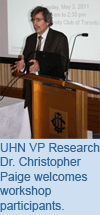 Despite urgent calls to improve the quality of health care, numerous population-based studies in Canada and elsewhere continue to demonstrate that health care delivery and outcomes vary from standards and recommendations that are based on the best available evidence. It is essential to investigate why these problems exist and how to fix them through the conduct of health services research (HSR). HSR is a multidisciplinary field of inquiry, both basic and applied, that examines the use, costs, quality, accessibility, delivery, organization, financing, and outcomes of health care services to increase understanding of the structure, processes, and
Despite urgent calls to improve the quality of health care, numerous population-based studies in Canada and elsewhere continue to demonstrate that health care delivery and outcomes vary from standards and recommendations that are based on the best available evidence. It is essential to investigate why these problems exist and how to fix them through the conduct of health services research (HSR). HSR is a multidisciplinary field of inquiry, both basic and applied, that examines the use, costs, quality, accessibility, delivery, organization, financing, and outcomes of health care services to increase understanding of the structure, processes, and 
 On May 3, 2011, the UHN Health Services Research Strategic Planning Workshop was held at The University Club of Toronto to discuss current and desired UHN HSR capacity, and how to establish a HSR platform. Led by TGRI Scientist Dr. Anna Gagliardi, the workshop involved internal and external stakeholders who collectively discussed the definition of HSR, and identified and prioritized the infrastructure and activities needed to realize this entity. The event was a successful forum for collecting information from a variety of stakeholders reflecting various professional roles and perspectives—further consultation, discussion and planning will follow to ensure broad input.
On May 3, 2011, the UHN Health Services Research Strategic Planning Workshop was held at The University Club of Toronto to discuss current and desired UHN HSR capacity, and how to establish a HSR platform. Led by TGRI Scientist Dr. Anna Gagliardi, the workshop involved internal and external stakeholders who collectively discussed the definition of HSR, and identified and prioritized the infrastructure and activities needed to realize this entity. The event was a successful forum for collecting information from a variety of stakeholders reflecting various professional roles and perspectives—further consultation, discussion and planning will follow to ensure broad input. OCI’s Dr.
OCI’s Dr. 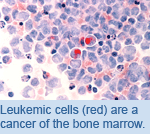 Patients suffering from acute myeloid leukemia (AML), the most common form of leukemia in adults, often experience recurrence of the disease within two years after treatment with chemotherapeutics due to incomplete elimination of all leukemic cells. However, new findings from TGRI’s Dr.
Patients suffering from acute myeloid leukemia (AML), the most common form of leukemia in adults, often experience recurrence of the disease within two years after treatment with chemotherapeutics due to incomplete elimination of all leukemic cells. However, new findings from TGRI’s Dr.  Parkinson’s disease (PD) is a neurological disorder affecting movement and brain function. The most effective treatment for PD is L-DOPA, which helps to restore the levels of the neurotransmitter dopamine in the brain. However, long-term use of L-DOPA may lead to motor complications, called dyskinesia. Previous observations noted that the chemical MDMA (3,4-methylenedioxymethamphetamine; also known as “ecstasy”) may enhance the therapeutic benefits of L-DOPA in PD patients.
Parkinson’s disease (PD) is a neurological disorder affecting movement and brain function. The most effective treatment for PD is L-DOPA, which helps to restore the levels of the neurotransmitter dopamine in the brain. However, long-term use of L-DOPA may lead to motor complications, called dyskinesia. Previous observations noted that the chemical MDMA (3,4-methylenedioxymethamphetamine; also known as “ecstasy”) may enhance the therapeutic benefits of L-DOPA in PD patients.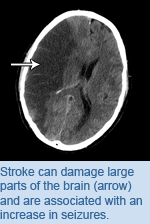 Stroke, an event where brain tissue is damaged either due to a disruption of local blood supply or bleeding in the brain, is the most commonly identified cause of seizures in the adult and aging populations. Seizures can occur within two weeks (early onset) or months to years (late onset) after stroke. Early onset seizures are considered to be a clinical emergency and are associated with worsened outcomes. Recent findings from a study led by TWRI's Dr.
Stroke, an event where brain tissue is damaged either due to a disruption of local blood supply or bleeding in the brain, is the most commonly identified cause of seizures in the adult and aging populations. Seizures can occur within two weeks (early onset) or months to years (late onset) after stroke. Early onset seizures are considered to be a clinical emergency and are associated with worsened outcomes. Recent findings from a study led by TWRI's Dr. 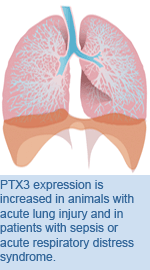 Recent work from the labs of Drs.
Recent work from the labs of Drs.  Dr. Richard (Dick) Hill, Senior Scientist at the Ontario Cancer Institute (OCI), is the recipient of the Henry S. Kaplan Distinguished Scientist Award for 2011. This prestigious award is given once every four years by the International Association for Radiation Research (IARR) in recognition of the scientific achievements and impact of researchers in basic and practical radiological sciences. The award was announced May 10th and will be presented by the IARR in August at the 14th International Congress of Radiation Research held in Warsaw, Poland.
Dr. Richard (Dick) Hill, Senior Scientist at the Ontario Cancer Institute (OCI), is the recipient of the Henry S. Kaplan Distinguished Scientist Award for 2011. This prestigious award is given once every four years by the International Association for Radiation Research (IARR) in recognition of the scientific achievements and impact of researchers in basic and practical radiological sciences. The award was announced May 10th and will be presented by the IARR in August at the 14th International Congress of Radiation Research held in Warsaw, Poland.
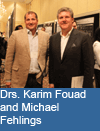 On May 18th, 2011, TWRI hosted its 11th Annual Research Day, which highlighted the groundbreaking basic and clinical research conducted by graduate and post-graduate trainees at the institute over the past year.
On May 18th, 2011, TWRI hosted its 11th Annual Research Day, which highlighted the groundbreaking basic and clinical research conducted by graduate and post-graduate trainees at the institute over the past year.